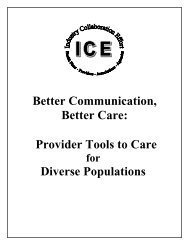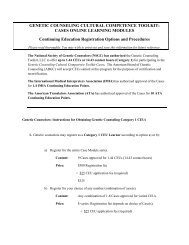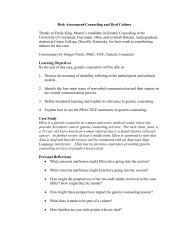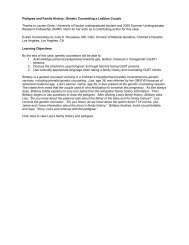making the business case for culturally and linguistically appropriate ...
making the business case for culturally and linguistically appropriate ...
making the business case for culturally and linguistically appropriate ...
You also want an ePaper? Increase the reach of your titles
YUMPU automatically turns print PDFs into web optimized ePapers that Google loves.
BUSINESS CASE THEMES,KEY FINDINGS AND LESSONS LEARNEDThis section discusses:• Major reasons organizations pursue CLAS in health care; <strong>and</strong>• Key findings <strong>and</strong> lessons learned with regard to implementation of CLASactivitiesWhy Organizations Initiate CLAS in Health CareWhile each of <strong>the</strong> CLAS projects documented in this report was driven by <strong>the</strong> individualorganization’s leadership, organizational characteristics <strong>and</strong> patient needs, four common<strong>the</strong>mes emerged:1. Minority <strong>and</strong> LEP Consumers are a Business Market. In certain areas of <strong>the</strong> U.S.“minority” <strong>and</strong> LEP consumers now constitute a majority. The U.S. Census has shown aconsistent increase in <strong>the</strong> number of immigrants <strong>and</strong> LEP populations in <strong>the</strong> past 20 years,<strong>and</strong> experts <strong>for</strong>ecast a dramatic increase in <strong>the</strong>se populations over <strong>the</strong> next 20-40 years.Census experts estimate that by 2050 <strong>the</strong> proportion of "minorities" in <strong>the</strong> U.S. will approach<strong>and</strong> perhaps exceed 50 percent. 12 With changing U.S. demographics, health careorganizations have an incentive to implement CLAS st<strong>and</strong>ards <strong>and</strong> become <strong>culturally</strong>competent to increase <strong>the</strong>ir appeal to minority consumers <strong>and</strong> maintain existing patientrelationships <strong>and</strong> increase <strong>the</strong>ir market share today <strong>and</strong> in <strong>the</strong> future. By advertising,implementing or visually displaying services that are <strong>culturally</strong> competent, health careorganizations could attract <strong>the</strong> preferred <strong>business</strong> of specific minority <strong>and</strong> LEP groups (e.g.,<strong>the</strong> Holy Cross Family Centered Maternity Suites Project <strong>and</strong> Bilingual Discharge Classes inSpanish). Health care organizations can use <strong>the</strong> CLAS st<strong>and</strong>ards to draw in new consumers<strong>and</strong> retain patients who want easier <strong>and</strong> more com<strong>for</strong>table access <strong>and</strong> quality, <strong>culturally</strong>competent services. As in <strong>the</strong> <strong>case</strong> of Holy Cross, offering CLAS programs to minoritypatients may also have a spill-over effect into o<strong>the</strong>r patient populations <strong>and</strong> may increaseoverall <strong>business</strong>.2. Government Requirements Compel Organizations to take on CLAS. Health careorganizations that want to continue receiving public funding or participate in public healthinsurance programs (e.g., Medicare, Medicaid) are required to provide services <strong>for</strong> LEPpatients by Title VI of <strong>the</strong> 1964 Civil Rights Act 13 , Presidential Executive Order 13166, <strong>and</strong>federal regulations. Whe<strong>the</strong>r this means translating member materials into o<strong>the</strong>r languages,offering language translation <strong>and</strong> interpretation services or o<strong>the</strong>r similar types ofprogramming, health care organizations are compelled to participate in CLAS initiatives.Organizations may look to <strong>the</strong> examples provided in this report <strong>for</strong> program ideas to meetstate <strong>and</strong> federal requirements.3. Cost-effective Spending <strong>and</strong> Subsequent Savings. Health care organizations are facedwith increasing accreditation dem<strong>and</strong>s, diverse patient populations <strong>and</strong> limited resources withwhich to provide care. Organizations need to find ways to implement effective programef<strong>for</strong>ts, while at <strong>the</strong> same time containing or decreasing costs associated with <strong>the</strong>se programs.Culturally incompetent care is inefficient <strong>and</strong> not cost-effective long-term. At a minimum,12 Minority Population Growth: 1995 to 2050; www.mbda.gov/documents/mbdacolor.pdf13 National Council on Interpretation in Health Care; http://www.ncihc.org/policyissues.aspx24



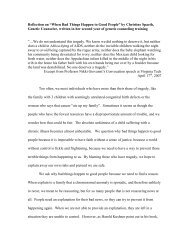
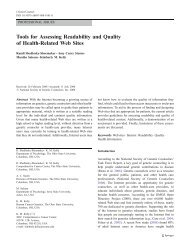

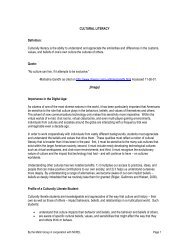
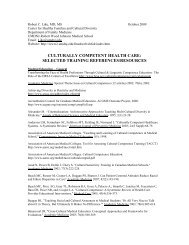

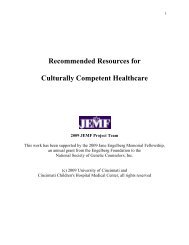
![Breaking Bad News PPT[1] - Genetic Counseling Cultural ...](https://img.yumpu.com/35003134/1/190x146/breaking-bad-news-ppt1-genetic-counseling-cultural-.jpg?quality=85)
